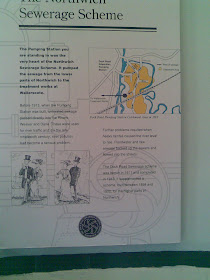Please click on any picture for a larger image.
Ivan and me at the Pumping Station this afternoon. Ivan's SS50 on the left, my C90 in the middle, and Malc's Townmate on the right.
The Pumping Station was built by Northwich Urban District Council in 1913 to pump sewage from the low lying areas of Northwich to the Wallerscote Treatment Works. Before it was built, the sewage was simply discharged into the river Weaver causing widespread pollution.
It is a single story round castellated building housing two single-cylinder Crossley gas engines each driving a Haywood Tyler three-cylinder lift and force pump. Sewage was collected in a tank in the basement of the building and pumped up out of the Weaver valley to the treatment works.
What made our visit today special was not only the chance to see the historic engines and pumps in action still in their original setting, but the two knowledgeable, enthusiastic, and interesting volunteer guides who explained the station to us.
A Hi-Viz clad Malc chats to one the two enthusiastic guides. The two engines are on the left, each with a red flywheel, and the two pumps are to the right. The black overhead pipe used to carry the raw sewage from the basement tank to the pumps. It must have been very smelly in here when the station was operating - which it did until the early 1970s.
Information boards in the building explain its history. Please click on any one to see a larger image.
Each gas engine is a single cylinder 4-stroke unit running on gas from the mains. They used to have a 'hot bulb' ignition system but have been modified first to have magneto ignition, and latterly a conventional set up using a battery, coil, points, and spark plug. The centrifugal governor drives a 'hit and miss' mechanism which allows activation of the gas inlet valve if the engine needs to develop power to maintain speed, and disables its activation if the engine already has sufficient speed. Thus, the engine doesn't fire every fourth stroke but only when it needs to, unless it is running slowly when each fourth stroke is a power stroke.
Each engine is connected to its pump through a friction clutch, so it can run without driving its pump if necessary.
Click Here for Ivan's video of one of the engines running, and then being clutched to its pump, which also runs. This video shows the 'hit & miss' system by which the governor maintains engine speed by allowing or disallowing the gas inlet valve to opened by the camshaft. Click here to see the volunteers attempting to start the second engine. Unfortunately there was a problem with its ignition system and it wouldn't fire up.
Click Here for Ivan's video of one of the engines running, and then being clutched to its pump, which also runs. This video shows the 'hit & miss' system by which the governor maintains engine speed by allowing or disallowing the gas inlet valve to opened by the camshaft. Click here to see the volunteers attempting to start the second engine. Unfortunately there was a problem with its ignition system and it wouldn't fire up.
Ivan and Malc outside the Pumping Station this afternoon
The station ran until 1972, when it was replaced by the adjacent electric-powered pumping station. In 1991 it re-opened after restoration by North West Water employees. A visit is highly recommended (but check opening times). The website is Here .
This whole area was once a hive of industry. In particular shipbuilding took place on the adjacent River Weaver. Everything from barges to tugs, and motor torpedo boats in WW2, and even the famous Clyde Puffer 'Vital Spark' of the Para Handy novels and TV series.
After a very interesting time watching the mechanisms at work and chatting to the guides we fired up the bikes and set off homeward. A stop at the Whipping Stocks for a pint of excellent 'Sam Smiths' bitter at a mere £1.80 rounded off the afternoon nicely.
Where next?
.







No comments:
Post a Comment